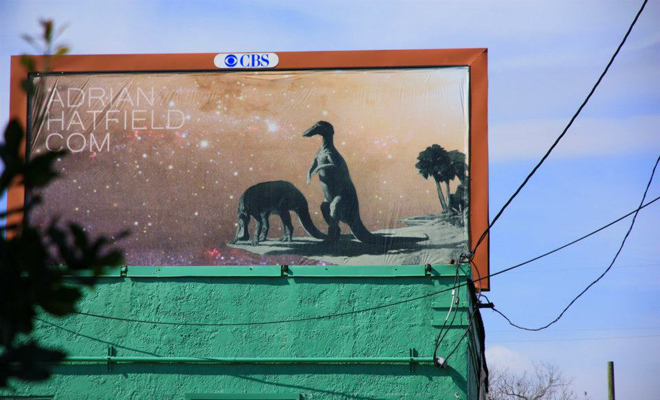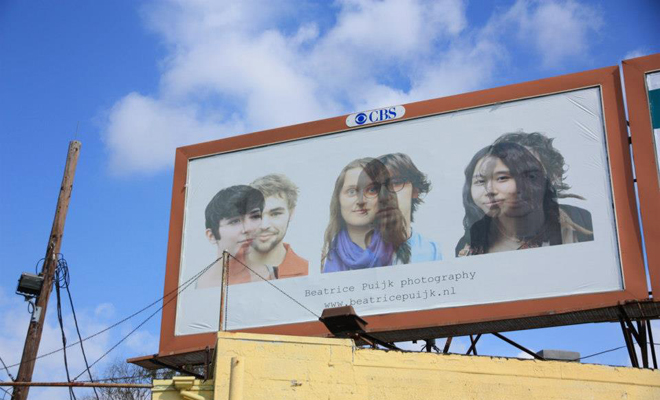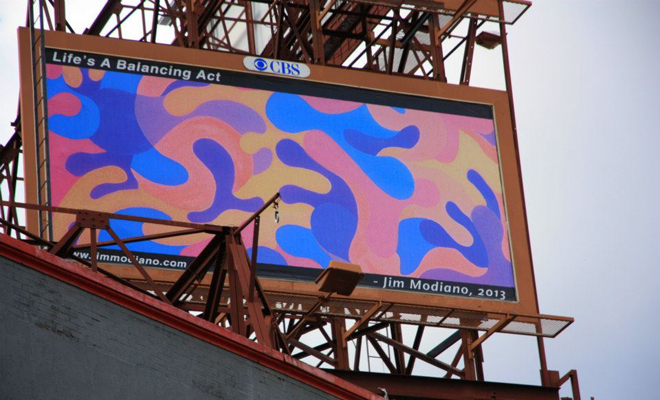Advertising Alternatives: Dave Rhodes and EXPOSE

View of a billboard featuring work by Adrian Hatfield at 4018 St. Claude Avenue as part of EXPOSE: New Orleans.
It wasn’t long into my conversation with artist Dave Rhodes before the impact of his work on his neighbors made itself apparent. It interrupted us in fact. We were sitting outside a Marigny coffee shop when a slim, middle-aged woman approached our table. She was brief but amiable, clearly excited to run into Dave on her morning coffee run, but quick to realize we were in the middle of an interview. She politely excused herself and Rhodes turned back to me with a sheepish smile. “Oh, I just built some art in her arbor,” he explained. Using the skills and contacts from his day job as a landscape architect, he had found a quiet, creative way to beautify a small piece of the city.
A garden arbor was a radical departure from what I had heard about Rhodes’ career trajectory, but I wasn’t surprised that he’d taken it on. I had come to talk with Rhodes about his brainchild, EXPOSE, and its latest art billboard project—a mega-sized exhibit of visual art on billboards across the city from January 21-February 18. As we spoke, the story of EXPOSE revealed itself to be larger than the art billboards it will display along (or close to) the parade routes and major thoroughfares for Mardi Gras and the Super Bowl.
Long before EXPOSE, the art arbor, or his move to New Orleans, Rhodes was already well practiced in making art that related to his environment with only the tools at his immediate disposal. Experience as a professional snowboarder led Rhodes to start photographing his fellow boarders for Snowboarder Magazine. The loss of his camera led to shooting what he called “weird, abstract” photos on his 2003 LG cell phone—shots that were ultimately exhibited in galleries around Los Angeles. There was his 2008 Duned series, a set of manipulated photographs that he took with a point-and-shoot camera, which were accepted for display with the U.S. National Parks Service. Now a part of NASA’s permanent collection, Rhodes estimates that the series has reached over one million viewers.

View of a billboard featuring work by Beatrice Puijk at the corner of North Galvez and Canal Streets as part of EXPOSE: New Orleans.
One could say Rhodes has been in the right place at the right time, but I think of his artistic success as a story of working with where you are and what you’ve got. While on a walk in 2010, Rhodes was struck by the visual discord of a billboard on the corner of Franklin Avenue and Burgundy Street—noting how strange it looked in the context of the neighborhood. He came up with the idea that has since grown into EXPOSE, envisioning a project that would interact with the New Orleans cityscape, showcase visual art to a wide audience, and use materials that the city has ready and waiting—billboards.
Rhodes isn’t just working on another platform for his own creativity. Last year during Mardi Gras, Rhodes partnered with London’s Art Below to put up billboards around New Orleans that featured his own work among other artists in 20 displays. This year, he has cut himself out of the exhibit entirely. The EXPOSE billboards now on view feature and promote a cross section of international artists without any mention of Rhodes or his organization. He chose the art with two criteria in mind: that it look good “blown up” and also have a positive message. Additionally, he wanted to feature artists whose careers could be enhanced by their inclusion in the project, and above all, who are as passionate as he is about the idea of their work being displayed so unconventionally.
EXPOSE is a way to “give back to New Orleans,” Rhodes says, and to work to benefit other artists, to beautify the city and to enhance Mardi Gras and Super Bowl experiences for residents and visitors alike. Most of all, Rhodes says, the billboards are meant to give all viewers a sense that “anything is possible.” You can make art that makes a big impact, if you only think creatively about what you’ve got around.

View of a billboard featuring work by Jim Modiano at the corner of Canal Street and University Place as part of EXPOSE: New Orleans.



